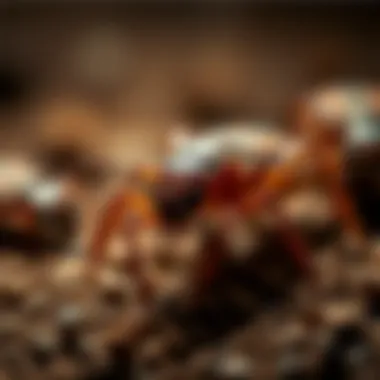Top Pest Control Solutions in Gilbert, AZ


Intro
Dealing with pests can feel like having a persistent uninvited guest at your home. It's a situation many homeowners in Gilbert, Arizona, are well acquainted with. From scuttling scorpions to pesky termites, these critters can wreak havoc if not kept in check. Not only can they damage property, but they can also pose health risks and create an overall uncomfortable living environment.
This comprehensive guide aims to equip you, the reader, with essential knowledge about pest control in Gilbert. We’ll explore various aspects of pest management—from identifying the little nuisances hiding in plain sight to outlining effective prevention strategies and treatment options. Whether you are a homeowner, renter, or pest control professional, understanding the local pest landscape and how to manage it is crucial.
By the end of this guide, you’ll be ready to tackle pest problems head-on, armed with practical tips, strategies, and answers to common questions. Let’s dive into the world of pest identification in Gilbert, where understanding is the first step towards freedom from unwanted guests.
Pest Identification
Understanding the pest problem is half the battle won. Identifying the specific pests invading your space is crucial for choosing the right method of control. Here's a closer look at common pests in Gilbert, how to spot them, and the signs that indicate an infestation.
Detailed Descriptions of Common Pests
- Termites: Often considered the silent destroyers, these wood-eating insects can cause extensive damage before they are detected. They usually swarm in spring, and their presence is indicated by discarded wings or mud tubes on wooden surfaces.
- Ants: Species like the carpenter ant and the harvester ant thrive in Gilbert. Carpenter ants tunnel through wood, while harvester ants gather seeds. Look for trails of ants and tiny piles of dirt or wood shavings for signs.
- Scorpions: These creatures are common in the Arizona desert and are more active at night. Look for dark, curved bodies with a segmented tail. They tend to hide in crevices and under rocks.
- Rodents: Mice and rats are not just cute; they can also be a nuisance. Signs of rodent activity include droppings, gnawed food items, and scratch marks along walls.
Signs and Symptoms of Infestations
It’s essential to stay vigilant. Here are some unmistakable signs of infestations:
- Damaged wood surfaces or hollow-sounding wood (evidence of termites).
- Odd trails of smaller insects leading to food sources (indicating ants).
- Hearing scuttling noises in walls or ceilings, especially at night (a red flag for rodents).
- Finding dead scorpions or other pests around the home.
Identifying the pest is just the beginning. The next crucial step is preventing them from making themselves at home. Let's move on to effective prevention strategies that will keep these pests at bay.
Preamble to Pest Control
Pest control is like a safety net for our homes. It’s crucial to protect not just our properties, but also our health and well-being. In Gilbert, AZ, where warm weather invites various critters, understanding pest control becomes even more vital. Whether you're a homeowner, a renter, or someone just looking to maintain a pest-free environment, this guide is your go-to resource. By grasping the essentials of pest control, you can better manage unwanted visitors, ensuring a comfortable living space.
Understanding the Importance of Pest Control
Pest control prevents not just annoyance but significant damage. Imagine waking up to find your favorite wooden furniture chewed up by termites. It’s disheartening and costly. Moreover, some pests, like cockroaches and rodents, carry diseases that could affect your family’s health. Regular pest management means you can avoid these nasty surprises before they become a big headache.
Besides damage and health concerns, effective pest control can improve your property’s value. A house that has been well-maintained and protected from pests is more appealing to potential buyers. Pest infestations can tarnish a home’s reputation and dissuade prospects. Therefore, investing in pest control not only safeguards your comfort but also enhances the appeal of your home in the long run.
Common Pests in Gilbert, AZ
In this part of the world, certain pests seem to feel right at home. Learning about these common pests will better prepare you to identify and address issues as they arise. Here’s a look at some of the main troublemakers in Gilbert:
Termites
Termites are a serious concern for homeowners in Gilbert. These wood-destroying insects tend to silently wreak havoc, often not revealing their presence until significant damage has been done. A key characteristic of termites is their diet, primarily cellulose, which makes wood their favorite treat. What makes them notable in this guide is the rapid speed at which they can cause destruction. For instance, a colony can consume a pound of wood per day.
Unique Feature: Termites live in colonies, often comprised of thousands of individuals, making them a formidable foe. The homes they inhabit can suffer severe structural damage before signs of infestation appear, increasing the urgency of pest control effectively.
Ants
Ants are another common nuisance in Gilbert. Species like the fire ant are particularly aggressive and can deliver painful stings. They are not only annoying but can also contaminate food sources in your home. A key characteristic of ants is their social nature, as they form colonies that operate under a strict hierarchy. This collective behavior allows them to invade homes in masses, making it tough to deal with an infestation.
Unique Feature: Ants leave pheromone trails to communicate with each other, leading more ants to the food source. This can turn a minor issue into a full-blown infestation quickly, signifying the need for prompt action in pest control.
Rodents
Rodents, specifically rats and mice, are adaptive creatures that thrive in urban environments. They can squeeze through tiny gaps and make themselves at home in attics, walls, and even kitchens. Their rapid breeding can lead to severe population booms, creating challenges that need to be managed effectively. A distinctive trait of rodents is their strong front teeth that continuously grow, pushing them to gnaw on various materials to wear them down.
Unique Feature: Rodents can spread diseases like hantavirus and leptospirosis, making pest control vital for ensuring a safe living environment.
Cockroaches
Cockroaches tend to be associated with uncleanliness, although they can infest even the tidiest of homes. These creatures are notorious for their resilience, able to survive without food for a month. A critical aspect of cockroaches is their fast reproduction rate, highlighting the urgency of effective pest control. Not only do they contaminate food and surfaces, but they also contribute to allergic reactions and asthma in vulnerable individuals.
Unique Feature: Cockroaches can live up to a week without their heads, which underscores their toughness and the necessity of immediate action when they make an appearance.
In Gilbert, AZ, understanding these pests is the first step towards maintaining a healthy, safe, and pest-free environment. Knowing what we're up against empowers us to take effective action.
Identifying Common Pests
Identifying common pests is a cornerstone of effective pest management, especially for homeowners and renters in Gilbert, AZ. Understanding what to look for can be the difference between a minor inconvenience and a full-blown infestation. Knowledge is power; by familiarizing yourself with these critters, you can act faster and potentially save yourself a lot of hassle and expense. This section aims to give a thorough overview of some of the most troublesome pests you may encounter, focusing primarily on termites—an insatiable foe in many homes.
Characteristics of Termites
Termites are small but formidable foes that can cause significant damage before you even know they're there. They thrive in colonies and are often referred to as social insects, operating as a cohesive unit. Among the key characteristics of termites is their diet; these pests primarily consume cellulose, which is found in wood, paper, and other plant materials. Their ability to consume and break down these materials makes them invaluable in nature, but it turns disastrous when they set their sights on your home.


Their bodies are typically soft and pale, making them somewhat inconspicuous. You won't see them trotting around haphazardly like ants. Instead, they tend to remain hidden. The most common types you might come across in Gilbert are Subterranean termites and Drywood termites. Knowing the distinctions between these types can aid in identifying the issues you might face with them.
Signs of Infestation
If you suspect that termites have made themselves at home in your residence, knowing the signs of infestation can help you address the situation swiftly. Here are the most salient indicators to be on the lookout for:
Mud Tubes
Mud tubes are one of the first signs that termites are at work. These tubes are typically made of soil, wood, and saliva, and they provide the termites with a protective tunnel. They usually run along the foundation of your home or within wall voids. Spotting mud tubes means your home is more than just a potential target; it’s already being utilized by a colony.
Key characteristics of mud tubes include:
- Structure: Roughly the width of a pencil, these tubes will be found in various colors depending on the soil type in your yard.
- Placement: Check areas that have a lot of wood or moisture.
Recognizing these tubes early on allows you to react before the damage compounds. They provide easy pathways for termites to travel and access wood structures.
Frass
Frass is another telltale sign of a termite infestation that should not be overlooked. This term refers to the droppings left behind by termites, often resembling tiny pellets of sawdust. If you notice this material, you can be sure that termites are not just visiting; they're actively munching away.
Key characteristics of frass are:
- Appearance: It can vary in color but is typically light to dark brown and resembles wood shavings or coffee grounds.
- Location: Check near wooden structures or wherever wood meets moisture.
Frass serves as both a direct warning and an indicator of how significantly your wood may already be damaged. It's like leaving breadcrumbs that lead right back to the source.
Wood Damage
Wood damage is perhaps the most alarming sign that termites are partaking in a party in your home. The damage often appears as hollowed-out wood or can show pellets and holes. As they tunnel through the wood, they compromise structural integrity, making it critical to assess any damaged areas promptly.
Key features of wood damage include:
- Visual Indicators: Look for blisters in paint or warped wood. Structural areas like beams can suffer greatly.
- Sound: Tapping on wood can give you an idea of its integrity; hollow sounds may suggest that it's been compromised.
Recognizing and addressing wood damage can help avert costly repairs down the road. Ignoring these signs can lead to a serious financial headache as you repair not just the wood but also potentially replace parts of your home.
Understanding what to look for provides a tactical advantage in the battle against pests like termites.
By identifying these pests early, homeowners and tenants can take proactive steps to mitigate damage, thereby preserving the integrity of their homes in Gilbert, AZ.
Prevention Strategies
Prevention strategies are a cornerstone of effective pest management. They are the proactive measures that homeowners can employ to minimize the chances of pest infestations. These strategies not only save time and money in the long run but also promote a healthier living environment. By investing in prevention, residents of Gilbert, AZ, can sidestep the headaches of dealing with pest control once an infestation occurs. Additionally, understanding and implementing these strategies creates a defensive buffer against a plethora of pests.
Home Maintenance and Inspection
Keeping a home in tip-top shape is integral to preventing pest problems. Regular inspections can uncover potential entry points and vulnerabilities in your property. Homeowners should regularly check for gaps around windows and doors, ensuring that seals are intact. If there are noticeable cracks in the foundation or walls, it might be time to pull out the caulk.
Another important element is to routinely examine plumbing connections and drainage systems, as leaks or standing water can attract pests. By doing so, homeowners make it difficult for pests like rodents and insects to establish any foothold.
- Routine Checklist:
- Inspect windows and doors for gaps.
- Check attic and crawl spaces for leaks.
- Seal any cracks in walls or foundations.
By staying vigilant, you can identify issues before they turn into larger problems.
Landscaping Practices
Your yard may seem far removed from your home, but poor landscaping practices can invite pests right to your doorstep. A well-maintained landscape not only enhances curb appeal but can also deter unwanted visitors. Homeowners should be cautious of overgrown vegetation and dense shrubbery, as these can provide a cozy habitat for pests like ants or termites.
Additionally, keeping plants trimmed and away from the house creates a natural barrier. Using gravel or rocks instead of mulching around home foundations can make it less attractive to termites. Also, ensuring that tree branches do not touch the roof can prevent rodents from gaining easy access to your attic.
- Landscaping Tips:
- Trim plants and shrubs, keeping them away from the home.
- Use rocks instead of mulch near the foundation.
- Prune trees to keep branches away from roofs.
These simple steps not only protect your home but also contribute to a systematic defense against pest invasions.
Moisture Control Techniques
Excess moisture can transform your home into a pest paradise. Many pests, including termites, thrive in damp environments, making moisture control essential in Arizona's dry climate, ironic as it may seem. Homeowners should regularly check for leaks in pipes, roofs, and basements – even the smallest leak can lead to significant pest problems.
Installing dehumidifiers or improving ventilation in areas like the basement or attic can help reduce moisture levels. Furthermore, homeowners should be proactive about drainage systems outdoors; ensuring that water flows away from the home prevents the formation of pools that pests can utilize.


- Moisture Control Measures:
- Fix leaky pipes and roofs promptly.
- Install dehumidifiers in damp areas.
- Manage drainage to direct water away from the foundation.
Controlling moisture not only deters pests but also promotes better air quality and protects the integrity of your home.
"An ounce of prevention is worth a pound of cure."
Taking these measures may seem trivial, but they can make all the difference in keeping pests at bay.
Treatment Options
When it comes to addressing pest issues in your home, understanding the various treatment options available is essential. This section takes a closer look at different methods for pest control, which can be categorized into natural approaches, chemical treatments, and professional services. With so many choices, it’s crucial to consider their effectiveness, safety, and long-term implications for both your household and the environment.
Natural Pest Control Methods
Natural pest control methods are increasingly popular among homeowners, particularly those who favor organic solutions. They often involve the use of various ingredients sourced from nature that can effectively deter pests without resorting to harsh chemicals.
Essential Oils
Essential oils have gained a reputation as powerful pest repellents. They are concentrated plant extracts that carry distinct fragrances, making them a beneficial option for pest control. Oils such as peppermint, lavender, and tea tree are known to deter common intruders like ants and spiders.
One key characteristic of essential oils is their safety. Unlike synthetic pesticides, these oils are typically less toxic to humans and pets, making them a more favorable choice for families with young children or pets around. Their unique feature lies in the strong aromas that many pests find unpleasant, causing them to avoid treated areas.
However, while essential oils can be effective to some extent, they may require more frequent reapplication compared to chemical treatments. They can sometimes work better as a preventative measure or in conjunction with other methods.
Diatomaceous Earth
Diatomaceous Earth (DE) is another compelling natural treatment that proves effective against a variety of pests, especially insects. Composed of the fossilized remains of tiny, aquatic organisms called diatoms, DE works by dehydrating insects that come in contact with it. When pests crawl over the powder, it scratches their exoskeleton, leading to dehydration and death.
The appeal of Diatomaceous Earth lies in its non-toxic nature, allowing for safe use around children and pets. It’s particularly beneficial because it’s not a chemical insecticide and can be used both indoors and outdoors. A unique feature of DE is its long-lasting effect; it doesn’t break down quickly, which means it continues to work even after application.
Yet, it’s important to keep in mind that DE is only effective against certain types of pests, mainly crawling insects. For flying insects, different methods might be needed. Additionally, it requires careful application to avoid inhalation of the fine particles.
Chemical Treatments
While natural methods have their merits, sometimes stronger measures are necessary. Chemical treatments can provide quicker action and more substantial results, especially in severe infestations. Homeowners must, however, weigh the benefits against potential health risks associated with chemicals.
Insecticides
Insecticides are perhaps the most well-known chemical treatment available for pest control. These substances are designed to kill insects effectively and swiftly. Chemical-based insecticides often contain active ingredients like pyrethroids, which interfere with an insect's nervous system to eliminate them quickly.
The primary appeal of using insecticides is their immediate effectiveness, which is especially crucial during a major infestation. They work quickly and can cover multiple pest problems at once. However, the downside includes potential toxicity to humans and the environment. Homeowners must handle these products with care and follow instructions meticulously.
Moreover, insecticides can lead to pest resistance over time, prompting the need for stronger solutions or a change in strategy. Thus, they should be used judiciously and as part of a comprehensive pest management plan.
Boric Acid
Boric acid is another chemical treatment that stands out in pest control. It works primarily as a slow-acting stomach poison for insects such as cockroaches and ants. When ingested, it disrupts the digestive system of pests, leading to their eventual demise.
One of the key characteristics of boric acid is its effectiveness even in small amounts, making it both cost-effective and efficient. It is also less harmful to humans and pets compared to more aggressive chemicals, giving it an edge in terms of safety. The unique feature of boric acid is that it can be used in gel bait formulations or as a powder, making it versatile for various applications around the home.
However, boric acid does have a limiting factor in that it requires careful placement, as improper usage can either be ineffective or pose risks to non-target animals. It may take some time to observe the effects, and prompt reapplication might be necessary in heavier infestations.
Professional Pest Control Services
When faced with a persistent pest problem, many homeowners consider enlisting professional pest control services. This route offers expert solutions tailored to specific issues, but there are important factors to weigh.
Choosing a Reliable Service
Selecting a reliable pest control service is paramount for effective pest management. Look for companies that have good reviews and positive feedback from clients. The key characteristic of a reliable service is certification and experience in pest control, ensuring they understand local pest issues.
The unique feature of professional services is the comprehensive approach they typically offer. They conduct thorough inspections, customize treatment plans, and provide ongoing monitoring if needed. However, opting for professional help can be more expensive than DIY methods, which is a consideration for many homeowners.
Understanding Costs
Costs associated with pest control can vary significantly based on several factors – including the type of service, the extent of infestation, and the treatments used. It’s crucial to understand these elements before committing to any service.
The key characteristic of understanding costs is transparency. A reputable company should provide clear pricing structures and outline what services will be included. One unique feature in this context is the possibility of seasonal discounts or bundled treatment plans for long-term service, helping homeowners manage expenses.
On the downside, the initial costs may be higher than expected, which could deter some homeowners from seeking professional help. However, investing in a reliable service can ultimately save money by preventing larger infestations down the line.
Understanding your pest control options is not just about choice; it's about finding what works best for your home environment.


DIY Pest Control: Pros and Cons
When considering how to manage pests around your home in Gilbert, AZ, the subject of DIY pest control holds significant weight. Many homeowners face the dilemma of whether to tackle pest issues on their own or to hire professionals. Exploring both sides of DIY pest control not only equips individuals with knowledge but also helps in making informed choices that could save both time and money down the road. In this section, we’ll examine the benefits and limitations of employing a do-it-yourself approach to pest management.
Benefits of DIY Approaches
- Cost-Effectiveness: The first thing that comes to mind is savings. Generally, buying pest control products from local stores is much cheaper than hiring a professional service. For those on tight budgets, this can be a significant advantage.
- Immediate Action: When pests invade your home, every minute counts. DIY pest control is ideal for individuals who wish to take matters into their own hands immediately. There are various products available on the market, such as traps for rodents or sprays for insects, which are often easy to use and can deliver quick results.
- Knowledge Gained: Engaging in DIY pest control also serves as a hands-on learning experience. Homeowners develop a better understanding of pest behavior, which can help in future prevention strategies. This knowledge can extend to teaching family members about the optimal ways to handle pest sightings.
- Customization: Everyone knows their home environment better than anyone else, right? With DIY solutions, you can tailor your pest control efforts to your specific needs. Whether you are dealing with ants in the kitchen or termites in the backyard, customizing your approach ensures that you’re specifically targeting the problem at hand.
Limitations and Risks
Despite the apparent benefits, DIY pest control comes with its own set of challenges and drawbacks that should be taken into account:
- Potential for Ineffectiveness: Just because something is DIY doesn’t mean it’s effective. Many products might only provide temporary relief without actually solving underlying issues. For example, simply spraying for ants may kill those visible, but that doesn't eliminate the queen or the nest.
- Health Hazards: Many commercial pest control products contain chemicals that can pose risks to health, especially if misused. Homeowners might not be aware of the proper safety precautions required when using certain pesticides, and mishandling products can lead to costly accidents or health threats to the family.
- Time-Consuming: DIY pest control can absorb significant time, particularly when trying various methods or dealing with severe infestations. Homeowners may not always have the luxury of time, especially when pests are causing damage.
- Lack of Professional Insight: Professionals have extensive experience and understanding of the different types of pests, their behaviors, and the most effective eradication methods available. DIYers lack this depth of knowledge; hence, there’s a risk of overlooking critical issues or using improper techniques that could exacerbate the problem.
The effectiveness of DIY pest control often hinges on the severity of the infestation and the knowledge of the homeowner. While it might work wonders in minor cases, more significant infestations often require professional intervention.
Myths and Misconceptions
In the realm of pest control, separating fact from fiction is crucial. Many homeowners rely on hearsay or anecdotal evidence, leading to ineffective treatments or increased pest problems. Understanding the common myths surrounding pests, specifically termites and DIY methods, empowers folks to discern reality from exaggeration. This journey through misconceptions provides insight that affects not just pest management but also the overall health of homes in Gilbert, AZ.
Debunking Common Myths Regarding Termites
Termites often find themselves on the receiving end of numerous gaps in knowledge. Here are a few widespread myths:
- Myth 1: Termites only infest old or damaged wood.
Truth: Termites are opportunistic feeders and can invade any wooden structure, regardless of its condition. They even feast on new wood if it is untreated or if there's accessible moisture nearby. - Myth 2: You can easily spot a termite infestation.
Truth: Termites are skilled at hiding, often causing damage from within the walls. Homeowners might not notice until the damage is significant. Regular inspections are key. - Myth 3: Pesticides will kill termites on contact.
Truth: Many pest control products are effective but designed to eliminate termites over time, not instantly. This slow action ensures that the affected colony or nest is thoroughly eradicated.
This misalignment between belief and reality can lead homeowners down the wrong path. Failure to address these myths often results in lost time, money, and peace of mind.
Clarifying Misunderstandings About DIY Treatments
The do-it-yourself movement has reeled in many eager homeowners, but misconceptions can make a simple task turn into a complicated mess. Here's the scoop:
- Misunderstanding 1: All DIY treatments are safe and effective.
Reality: While many natural remedies exist, not all are scientifically validated to work against pests like termites. For example, using vinegar might deter some pests, but it won’t touch termites. Simplicity can lead to oversights; proper identification of the pest is crucial. - Misunderstanding 2: It’s cheaper to handle pests yourself.
Reality: Initial savings might seem appealing, but if DIY efforts flop, the cost to hire professionals later could rise significantly. - Misunderstanding 3: You can always fully eliminate a pest problem on your own.
Reality: Pests can return if not dealt with correctly. A thorough approach typically includes understanding the pest’s lifecycle, applying the right treatments, and often, regular monitoring.
It’s essential to approach pest control with informed strategies, whether through DIY methods or professional treatments.
In summary, arm yourself with knowledge about pests and their control methods. By challenging myths and clarifying misunderstandings, homeowners in Gilbert can proactively address pest issues while ensuring the integrity of their living spaces.
For more information on pest behavior, visit reputable resources such as National Pesticide Information Retrieval System.
Understanding pests is half the battle; an informed defense is the best offense.
Long-term Pest Management
Pest management is not a one-time deal. For residents of Gilbert, AZ, understanding long-term pest management is crucial for creating a sustainable, pest-free home environment. This strategy goes beyond merely reacting to pest issues as they arise. Instead, it emphasizes a proactive approach that prioritizes prevention, early detection, and ongoing control measures.
By implementing a long-term plan, homeowners can not only reduce the chances of a severe pest infestation but also limit the financial implications and emotional stress that often accompany such events. It’s like having a safety net; if you prepare well, you won’t fall hard. In a place like Gilbert, where pests such as termites and rodents can wreak havoc, being ahead of the game is invaluable.
Creating a Pest Management Plan
A pest management plan is like a blueprint for maintaining control over pest populations. Crafting an effective plan requires careful consideration of your home’s unique circumstances and environments.
- Assessment: Start with an evaluation of your property. Identify areas that are prone to pest activity. Look for cracks in the foundation, standing water, or clutter that could provide hiding spots.
- Setting Goals: What do you aim to achieve? Whether it’s eliminating a current pest issue, preventing new infestations, or both, knowing your goals is essential in guiding your actions.
- Preventive Measures: This involves implementing changes that discourage pests. Examples include sealing entry points, maintaining clean outdoor areas, and utilizing appropriate landscaping techniques to minimize hiding places.
- Integration of Treatments: Combine natural remedies with professional assistance when necessary. This balanced approach often yields the best results. Employing essential oils as repellents and enlisting help for more stubborn pests can be part of a solid plan.
- Education: Staying informed about pest behaviors and seasonal patterns will empower you to prepare better. Knowing that certain pests thrive during specific times can help you take preemptive action, much like an early bird catching the worm.
Monitoring and Evaluation
Once your pest management plan is in motion, ongoing monitoring is key to its success. It’s important to keep a watchful eye on the indicators of pest activity. Regular evaluations can save you from larger issues down the line. Here’s how to implement this:
- Routine Inspections: Conduct monthly inspections of your home and yard. Look for signs of pests, such as droppings, nests, or gnawed materials. Regular checks can catch infestations before they escalate.
- Document Findings: Keeping a log of what you observe will help in evaluating trends over time. If you notice a spike in pest sightings during a particular season, it’s a cue to adjust your management strategies.
- Feedback Loop: Engage with pest control professionals to discuss your observations. Their expertise can provide insights that refine your plan. If something’s not working, don’t hesitate to revisit your approach altogether.
“An ounce of prevention is worth a pound of cure.” — Benjamin Franklin
Long-term pest management requires vigilance and adaptability. By crafting a thoughtful plan, actively monitoring conditions, and evaluating the effectiveness of your methods, you can maintain a safe, comfortable environment in your home for years to come.
Culmination
When it comes to maintaining a home, pest control stands as a fundamental aspect many homeowners might often overlook. The significance of efficiency in pest management cannot be understated, especially in a climate like Gilbert, Arizona, where various types of pests flourish. A strong pest control approach not only safeguards our living spaces from unwanted intruders but also ensures the well-being of our families and pets.
In this article, we've comprehensively explored multiple facets of pest control— from understanding common pests like termites and ants to delving into effective prevention techniques and treatment options, both natural and chemical. Homeowners are thus equipped with knowledge that can help demystify the pest control industry and empower them to make informed decisions.
Recap of Key Points
- Understanding Pests: We discussed the common pests inhabiting Gilbert and how they can affect your property if not managed timely.
- Identification and Strategies: Homeowners learned how to identify these pests and recognize signs of infestation, while also discovering essential prevention strategies.
- Treatment Options: A look into both DIY methods and professional services revealed suitable approaches for different situations, ensuring every budget is catered for.
- Myths Dispelled: The article aimed at debunking myths surrounding pest control, fostering clarity and understanding.
- Long-term Management Plans: We highlighted the importance of establishing ongoing pest management plans to protect against future infestations.
Encouragement for Proactive Pest Control
The journey of pest control doesn’t end once a treatment is applied; in fact, it’s a continuous process. Staying proactive is key. Homeowners should regularly inspect their properties, maintain cleanliness, and continue to educate themselves on best practices in pest management. Each home is unique, and adapting pest control measures to fit individual needs will make a world of difference.
Remember, an ounce of prevention is worth a pound of cure. Investing time in prevention strategies can save homeowners from hefty expenses and stress down the line. Whether you opt for DIY solutions or engage professional services like Truly Nolen or Terminix, it’s the informed choices made today that will yield a pest-free tomorrow. For more insights, you can check resources at Wikipedia or visit forums on Reddit to share tips and experiences with like-minded individuals.



